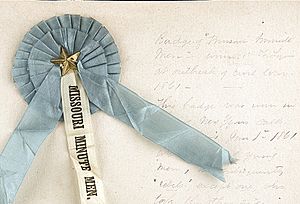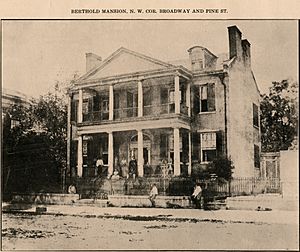Minutemen (Missouri Secessionist Paramilitaries) facts for kids
The Minutemen was a group of armed citizens in St. Louis, Missouri. They were active in early 1861, just before the American Civil War began. This group supported the idea of states leaving the United States, which is called secession. Many members later joined Missouri's state military or the Confederate Army.
How the Minutemen Started
The Minutemen group in St. Louis began in January 1861. It was formed by people in St. Louis who supported the Southern states. They wanted Missouri to leave the Union, or they opposed the U.S. government forcing Southern states to stay. Members signed a promise to support Southern states if the government used force. They also called for Missouri to secede if there was a big conflict. Many members had been active in political groups before this.
The Minutemen started at the same time as other groups that supported the Union. These Union-supporting groups included Republican Party clubs and German-American athletic clubs. Most Minutemen members were younger men who felt a strong connection to Southern culture. Some of the main organizers were Colton Greene, Basil W. Duke, and J. Rock Champion.
The Minutemen had their main office in the Berthold Mansion in downtown St. Louis. This was at the corner of 5th and Pine Streets. Members would challenge Union supporters in St. Louis. They also watched the St. Louis Arsenal, which was a U.S. government weapons storage site.
Minutemen members wore a special blue badge called a cockade. They gathered weapons and formed temporary military units. They also practiced military drills, just like the pro-Union groups did. A new state law said unofficial military groups were not allowed. However, state officials did not stop the Minutemen. Instead, on February 13, 1861, General Daniel M. Frost officially made the Minutemen part of the Missouri Volunteer Militia. They became the 2nd Regiment of this militia.
Through March and April, the Minutemen kept finding new members. They prepared for war and faced their Unionist opponents in St. Louis. One event almost led to a fight. Early on March 4, 1861, Minutemen members raised "secessionist" flags. They put them over the St. Louis Courthouse and their Berthold Mansion office.
The flag at the courthouse was quickly taken down. But the flag at Berthold Mansion kept flying. Union supporters felt angry about this symbol of secession. They demanded it be removed and tried to enter the building to take it down. This led to pushing and shoving. It could have turned into a violent fight. But the Mayor and other important Union leaders in St. Louis stepped in. The "secessionist" flag continued to fly until May.
The Camp Jackson Incident
In April 1861, Governor Claiborne Fox Jackson announced a statewide militia gathering for early May. On May 3, Minutemen members gathered at "Camp Jackson." This camp was at Lindell's Grove, just outside St. Louis. They were now part of the 2nd Regiment, Missouri Volunteer Militia. Lt. Col John S. Bowen was their commander. Many people in St. Louis, including the Minutemen, thought this gathering was a plan to attack the St. Louis Arsenal.
On May 8, 1861, a shipment of cannons, guns, and ammunition arrived. It came from the Confederate Government. These weapons had been taken from a U.S. Arsenal in Baton Rouge. Missouri militiamen moved them to Camp Jackson. Captain Nathaniel Lyon, who was in charge of the Federal Army's Western Department, found out about these captured U.S. weapons at the camp.
This, along with the Minutemen joining the militia, made Captain Lyon decide. He believed General Frost and his men were planning to rebel against the government. So, on May 10, Lyon marched his soldiers to Camp Jackson. His force included U.S. Regulars and Missouri Volunteers. They arrested the militia without firing a shot.
However, as Lyon tried to march the militiamen back to the Arsenal, angry citizens confronted his soldiers. During the riot that followed, 28 people were killed. More than 100 were injured. Most of the dead and injured were civilians.
What Happened Next
Right after the incident, Federal forces searched and closed the Minutemen's office at the Berthold Mansion. The Minutemen who were captured at Camp Jackson were held briefly at the St. Louis Arsenal. About half of the militiamen had managed to escape. All the captured members promised not to fight against the U.S. government until they were officially released. They were set free on May 11, 1861.
After being released, some Minutemen stopped supporting the cause. Others believed their arrest was illegal and their promise was not binding. They immediately joined the secessionist Missouri State Guard. Some went south to join the Confederate States Army. A third group stayed in St. Louis as captured soldiers on parole. They were later exchanged for Federal troops captured at the Battle of Lexington (Missouri). These troops were then sent down the Mississippi River by boat. There, they joined the Southern forces.
Many of the Minutemen became very successful in the Confederate Army. Basil W. Duke took command of John Hunt Morgan's cavalry after Morgan died. He was promoted to Brigadier General. Colton Greene was promoted to Colonel in the Confederate Army. He commanded a group of soldiers in the war areas west of the Mississippi River.



